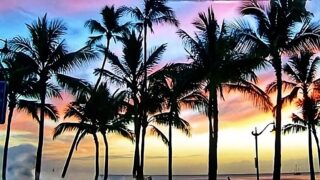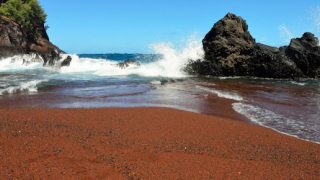We were booking a week-long stay in Kona when something new appeared on the payment screen. It sat there like a standard line item, labeled “Weather Guarantee” with a daily cost of $16.40. For the week, the total came to $115. In return, the offer promised $275.50 for any day with more than five hours of rain between 8:00 a.m. and 8:00 p.m.
Rain insurance in Kona felt like the hospitality equivalent of selling snow to Eskimos. Kona is one of the driest places in the state, chosen by visitors precisely because it seldom rains. Twenty-seven inches of rainfall a year, and now hotels want to sell protection from weather that barely exists.
What the Weather Guarantee actually is.
The offer comes from a California company called Sensible Weather. Hotels integrate it into their booking engines, and when guests click yes, they are entering a contract with Sensible, not the hotel. The company collects the guest’s name, email, and phone number and then monitors NOAA forecasts and weather data. When the system detects the right amount of rain during the specified hours, the payout is triggered automatically. There is no paperwork or human judgment. The forecast decides.
This feature spread across Hawaii after Sabre integrated Sensible Weather into its SynXis platform in September 2024. Hotels could activate it almost overnight.
Why Hawaii hotels love it.
This is not about customer service. It is a profit center. Hotels pay nothing to offer the Weather Guarantee. They receive their room revenue, then are paid again when a guest adds $16.40 per day for reassurance. Hotels earn a revenue share on every Weather Guarantee sold with zero operational cost.
Sensible claims it boosts booking conversions by three to nineteen percent. In plain terms, fear sells. Guests see rain mentioned on the payment screen and assume risk they never considered. Hotels profit from that moment of doubt.
It is a perfect setup. The hotel carries no risk, the outside company carries little risk, and visitors pay to insure against weather that rarely qualifies.
Hawaii microclimates make payouts even less likely.
There is another layer Sensible does not highlight. Microclimates define Hawaii. It can rain in one valley and be sunny a mile away. Visitors may spend their day hiking, shopping, touring, or driving far from where they sleep. Sensible does not care about any of that.
The guarantee is tied to the hotel’s exact geolocation. Not the island. Not the region. Not where you spent your day. Only the specific latitude and longitude of the hotel you booked. If that point on the map does not receive five continuous hours of measurable rain between eight in the morning and eight at night, you get nothing.
A visitor staying in Waikiki could spend a thoroughly drenched day on the North Shore and receive no payout. A guest at the Fairmont Orchid could get hammered by afternoon rain in Waimea, but if the Kohala Coast stays dry, nothing triggers. The guarantee is based on the weather at the hotel, not the weather you actually experienced.
That single detail makes the odds of a payout in Hawaii even smaller than they first appear.
Why it almost never pays in Hawaii.
Everything hinges on the five-hour threshold. It must be measurable, continuous precipitation. Hawaii weather almost never behaves like that. Most islands get fast moving showers, sudden squalls, or tradewind bursts that do not linger long enough.
Nighttime rain does not count. A three-hour downpour at 4:00 a.m. is irrelevant. Big Island evening showers are also irrelevant. Even a day that feels ruined can fall far short of the required hours.
If you ever get five hours of daytime rain in Hawaii, especially on the leeward side, you are likely dealing with a winter storm or Kona low with impacts far beyond losing pool time.
What visitors actually complain about.
Anyone working in Hawaii hospitality knows how intense expectations have become. Rob’s friend, a manager at the Grand Hyatt, recalls holiday weeks when guests went ballistic over a two-hour shower. Others demanded refunds for cloudy afternoons. Some insisted that their rate should be lowered because the day did not live up to the brochure’s expectations.
Those guests would never qualify for a payout. Not even close. Visitors want emotional reassurance. The guarantee only pays when the data says so.
That gap between feeling and fact is the heart of this story.
What really disrupts Hawaii trips.
Weather can ruin Hawaii days, but not in the way this product measures. Flash floods close trails. Streams rise suddenly and trap hikers. Helicopters stay grounded because of the wind. High surf can cancel boating activities, and roads close when debris slides across them.
These disruptions impact visitors far more than steady rain, yet none trigger a payout unless they align with hours of daytime precipitation. Hawaii’s most memorable weather problems do not fit neatly into a five-hour formula.
Would you pay $16.40 a day to insure your Hawaii weather? Have you ever experienced more than five hours of daytime rain here? Please share your comments below.
Get Breaking Hawaii Travel News







To answer your question…. Absolutely not! What a ridiculous “insurance”. Even if it rains there are many interesting indoor activities (or shopping) to occupy me. And rain in Hawaii has its own beauty.
Nope. Never have experienced more than an hour of rain on Maui in all our years of visiting the Islands. What a grift!
So, what defines “rain”. Drizzle? Down pour” Meaured by inches of rain water? Who measures inches of rain? Where is inches of rain measured? Each specific location where room is charged? Rain may come down on parts of the hotel’s acreage and not all.
If I had a hotel reservation in Wahiawa in March (are there hotels in Wahiawa?) I might get it. Otherwise, no.
The article doesn’t state this but I have to presume there are requirements for when you can buy this guarantee. Certainly not just a week or two before arrival when the long range forecast is available.
It’s pure marketing genius. I’m sure they’re making good money but maybe it means fewer guests whining about rain to the front desk staff. And yes, I’ve experienced the type of weather but on Kauai, not the Big Island. I would never spend money on this though.
The fact that it is tied to the hotels geographic location makes sense. How else would they do it? If a tourist decides to spend the day on the leeward side of an island then that’s on them.